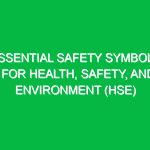Introduction
The symbol for toxic hazard plays a crucial role in the Health, Safety, and Environment (HSE) domain. This symbol, recognized internationally, acts as a visual warning of the potential dangers posed by toxic substances. With the increasing complexity of chemicals used in various industries—from manufacturing to agriculture—understanding this symbol is vital for ensuring Workplace Safety and protecting the environment. In this article, we will delve into the significance of the toxic hazard symbol, exploring its implications, the associated risks, and Best Practices to mitigate them.
What is the Symbol for Toxic Hazard?
The symbol for toxic hazard is depicted as a skull and crossbones, universally recognized as an emblem of danger. This symbol signifies that a substance can cause serious health Effects, including death, if ingested, inhaled, or absorbed through the skin. The use of this symbol transcends cultural and linguistic barriers, making it an essential part of Safety protocols worldwide.
In the context of HSE, the toxic hazard symbol serves multiple purposes. It alerts workers and the public to the presence of harmful substances, encourages safe handling practices, and ensures compliance with legal Regulations regarding hazardous materials. Understanding this symbol is the first step in creating a safer work environment and preventing accidents associated with toxic exposure.
The Importance of Understanding Toxic Hazard Symbols in HSE
Understanding the symbol for toxic hazard is paramount for several reasons:
- Risk Awareness: Knowledge of toxic substances and their associated symbols enhances risk awareness among employees. This proactive approach can help prevent accidents before they occur.
- Compliance: Familiarity with the toxic hazard symbol ensures compliance with local and international regulations pertaining to hazardous materials.
- Emergency Preparedness: In the event of an accidental exposure or spill, recognizing the toxic hazard symbol can lead to quicker response times and effective emergency measures.
Through education and Training, organizations can create a culture of Safety that minimizes risks associated with toxic substances.
Key Concepts and Components of Toxic Hazard Symbols
To fully grasp the implications of the toxic hazard symbol, it’s essential to understand its components and the concepts surrounding it. Here are some key aspects:
1. Classification of Hazardous Materials
Chemicals are classified based on their potential Hazards, which include toxicity, flammability, and reactivity. The toxic hazard symbol specifically pertains to substances that can cause significant harm to human health. Examples of such materials include:
- Heavy metals (e.g., lead, mercury)
- Pesticides
- Industrial solvents
- Certain pharmaceuticals
2. Routes of Exposure
Understanding how individuals can be exposed to toxic substances is critical. The main routes of exposure include:
- Inhalation: Breathing in toxic vapors or dust can lead to respiratory issues and systemic toxicity.
- Ingestion: Consuming contaminated food or water can introduce toxic substances into the body.
- Dermal Contact: Skin exposure to chemicals can result in absorption, leading to acute or chronic health effects.
Each of these exposure routes necessitates specific Safety Measures and controls to protect workers.
3. Safety Data Sheets (SDS)
Safety Data Sheets are essential documents that provide detailed information about hazardous substances, including their properties, hazards, handling Procedures, and emergency measures. Each toxic substance should be accompanied by an SDS, which must be readily accessible to all employees. The SDS will typically include:
- Identification of the substance
- Hazard identification
- Composition and information on ingredients
- First-aid measures
- Fire-fighting measures
The SDS is an invaluable resource for understanding the risks associated with a specific chemical and the Precautions necessary for safe handling.
Risks and Safety Considerations Related to Toxic Hazard Symbols
Understanding the risks associated with toxic substances is vital for effective hazard management. The potential health effects of exposure can range from mild irritation to severe chronic illnesses or even death. Here are some key risks associated with toxic Hazards:
1. Acute vs. Chronic Effects
Toxic substances can cause both acute and chronic health effects. Acute effects occur shortly after exposure and can include symptoms like headaches, dizziness, and nausea. Chronic effects develop over time and may result in long-term health issues such as cancer, reproductive harm, or organ damage. Recognizing these effects is essential for timely intervention and treatment.
2. Environmental Impact
Toxic substances not only pose risks to human health but also to the environment. Improper disposal or spills can contaminate soil and water, leading to ecological damage and affecting wildlife. The symbol for toxic hazard serves as a reminder of the responsibility organizations have to minimize their environmental footprint and adhere to sustainable practices.
3. Legal and Financial Consequences
Non-compliance with regulations regarding toxic substances can lead to significant legal and financial repercussions. Organizations may face fines, legal actions, and damage to their reputation. Understanding and adhering to the guidelines associated with the toxic hazard symbol is crucial for maintaining regulatory compliance and protecting organizational integrity.
Best Practices for Managing Toxic Hazards
Implementing Best Practices for managing toxic hazards is essential for safeguarding the health and safety of employees and the environment. Here are some recommended practices:
1. Training and Education
Regular training sessions for employees on the risks associated with toxic substances and the proper use of the toxic hazard symbol are essential. Engaging training programs can enhance knowledge retention and promote a culture of safety.
2. Proper Labeling and Signage
Ensuring that all toxic substances are appropriately labeled with the toxic hazard symbol is critical. Clear signage in areas where Toxic Materials are used or stored helps reinforce awareness and preventative measures.
3. Personal Protective Equipment (PPE)
Depending on the nature of the toxic substance, appropriate PPE must be provided and worn by employees. This may include gloves, masks, eye protection, and protective clothing to minimize exposure risks.
4. Emergency Response Plans
Developing and maintaining an effective emergency response plan is vital for managing accidental exposures or spills. This plan should include Evacuation Procedures, first aid protocols, and contacts for emergency services.
Regulations and Standards Governing Toxic Hazard Symbols
Numerous regulations and standards exist to govern the use of toxic hazard symbols and the management of hazardous materials. Key regulations include:
1. OSHA Standards
In the United States, the Occupational Safety and Health Administration (osha) establishes standards for hazardous communication, requiring employers to inform workers about the presence of toxic chemicals in the workplace. The OSHA Hazard Communication Standard (HCS) mandates the use of labels, safety data sheets, and employee training.
2. GHS Regulations
The Globally Harmonized System of Classification and Labeling of Chemicals (GHS) aims to standardize the classification and labeling of chemicals worldwide. Under GHS, the toxic hazard symbol is clearly defined, ensuring consistency across countries and industries.
3. Environmental Regulations
Various environmental laws, such as the Resource Conservation and Recovery Act (RCRA), govern the proper handling and disposal of hazardous waste, including toxic substances. Compliance with these regulations is essential for protecting public health and the environment.
Conclusion
The symbol for toxic hazard is more than just an image; it represents a critical aspect of health, safety, and environmental management. Understanding its significance is essential for mitigating risks associated with toxic substances, ensuring compliance with regulations, and promoting a culture of safety. By implementing best practices and adhering to legal requirements, organizations can create safer workplaces and contribute to environmental Sustainability. As industries evolve and new chemicals are introduced, continuous education and vigilance are necessary to maintain safety standards. Recognizing the importance of the toxic hazard symbol is a fundamental step toward a safer and healthier future for all.


